“I don’t believe in the gods, but last night I prayed to them that you would come – and you did! And now I believe in them!”
The man’s eyes were bright as he towered above me. I sat uncomfortably in the chair he offered, wishing he’d at least sit down too. The restaurant around us was empty – no small wonder, as it was 4pm – and I wondered how on earth I was going to get out.
‘Puma’ is Bolivian, but has lived all over South America selling handmade jewellery. More often than not he takes his eight year old son with him – ‘we are like best friends’, he told me.
Over a plate of chicken kadhai curry the night before, the Indian restaurant owner stood at the side of my table as I scooped up mouthfuls of curry with a piece of naan bread, and informed me that Puma is actually a drug dealer.
“The jewellery business is just a front,” he said. “He hides everything in the kid’s pockets. Nobody’s going to pat the kid down, are they?”
I glanced across at the apparent dealer, busy with a piece of wire and a pair of pliers, a smile still faintly visible on his face after he successfully managed to input his number into my phone.
Without any permission asked for, I might add.
I’d been summoned into the curry house that afternoon by way of the balcony window. Puma saw me passing in the street and shouted hello; and because I’d ignored his numerous phone calls at 1am the night before, I felt obliged to go in and apologise.
Such is the mistake of the ever polite English girl, who hadn’t envisaged it would lead to being sat down in a chair and spoken over like some kind of ceremonial deity.
Luckily, one of the restaurant workers saved me with the successful YouTube loading of a Bollywood song I’d hummed copiously throughout my time in India – and I was able to escape from under Puma’s nose. And when I finally made it out onto the streets of La Paz again, I had a stern talking to with myself. Despite finding the tastiest curry outside of India in this restaurant, it simply wasn’t worth the risk to go back again.
Contradictions in La Paz, Bolivia
After spending a month living in La Paz, I’m still intrigued by the contradictions of this city. It’s a place that defies normal conventions. People are happy in the shade and keep their stern faces turned away the sun; the poor live higher; and the city prison charges its inmates for cells of varying levels of luxury – though the entire prison is run more like an apartment complex than an incarceration facility.
Meeting Puma was the final bizarre Paceño contradiction; because in a city where nobody smiles, how on earth could I have guessed that a drug dealer would present me with a handmade flower made from bent wire, while his son played with a toy dinosaur and showed no concern about the parcel of cocaine hidden down his trousers?
Puma left me with no choice but to adopt my own version of the Paceñan attitude – when I passed by his jewellery stall the next day, I kept my head down and my mouth unsmiling. Sometimes a little bit of coldness is exactly what you need.
But lets start from the beginning, when I arrived in La Paz – and immediately realised I’d underestimated the chill of this Bolivian city.
My first experience in Bolivia? Being freezing.
Still fresh with the memory of Brazil’s heat, I stepped off the plane at El Alto airport and was greeted by numerous figures in coats, scarves, big fluffy boots and thick socks wrapped around their ankles.
Picking up my backpack from the carousel, I mentally rifled through the clothes within, and felt a little uncomfortable. Thin trousers: check. Flip flops: already wearing. Assortment of vests and T-shirts? Sure. But with one fleece, a sarong that doubled as a scarf and just four pairs of socks as my stock ‘bad weather protection’ gear, I had the distinct feeling I wasn’t going to be a match for the coldness of La Paz.
Read more: My Ultimate Travel Guide to Backpacking Bolivia
My biggest problem with travelling in South America has been the constant change of climates. Spending almost two months in the thick, pressing heat of the north Colombian coast, the cool mountain breezes of the Brazilian mountains and every climate in between had thrown my internal thermostat way off.
But La Paz was definitely the chilliest temperature I’d hit so far.
At 3500m above sea level, the city is famed for being the highest ‘capital’ in the world (although you may want to check with Sucre first about that). Built in a valley, La Paz crowds itself into a limited amount space and ends up sprawling across the nearby mountains.
The geography of La Paz reflects society, but it’s somewhat backward; the higher you live, the poorer you’re going to be. The lowest neighbourhoods are where the richest people live, because the climate is significantly warmer: some days there’s a five degree difference in temperature between affluent Zona Sur and the peaks of El Alto.
Then there are the hills; rising steeply from each side of the Prado, the city’s central street. Before arriving, I read a piece of advice that helpfully pointed out, “if you don’t know where you are in La Paz, just walk downhill. Eventually you’ll end up on the Prado.”
So, in a distinct effort to warm myself up, the Prado was the first street I wandered along.
Walking is a tried and tested sightseeing method. A perfect antidote to the shivering I’d become accustomed to in my chilly hotel room and, because I was still nervous of getting lost catching the ubiquitous trufi buses that ran helter-skelter across the city, it was also the best way to glean my first impressions of Bolivia.
Read more: Five things to know before travelling to Bolivia
The beauty of La Paz is all in the details
Narrow, curving, hilly streets. Peeling paint behind the myriads of jumpers, gloves, hats and scarves for sale, hanging above windows and around doorways.
Intricately plaited black hair hanging down the backs of countless women, shoulders wrapped with woven coloured shawls. A stern resolve to keep all skin covered, despite the brilliant sunshine.
Near to my hotel, I walked through streets filled with market stalls; or, rather, lines of women sitting on the pavement, their striped, woven awayu cloth laid flat, and covered with fruits, vegetables, and piles of fresh cut flowers.
I passed old men in baseball caps at mobile carts, squeezing oranges for juice. There were peach halves suspended in glass tumblers on display.
I had my eye caught by groups of army men sauntering along the street; by strutting teens with bowl cut hairdos and thin wisps of hair hanging down the backs of their necks.
Most arresting of all were the young boys who squatted at the roadside, their faces obscured by homemade, hand-cut balaclavas, who offered tins of bright black polish for shining shoes.
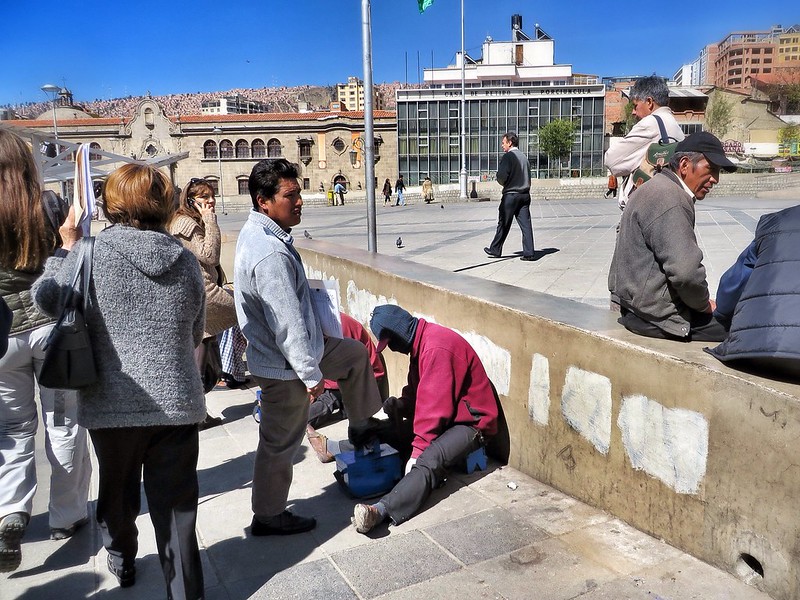
A shoe-shiner in La Paz. These boys hide their faces because the profession has a reputation for being one of the worst jobs in Bolivia.
Everywhere, my eye was caught by continuous details.
Toilet brushes stuck upright like flowers. Shoes stacked into fruit-like pyramids on wooden trestle tables.
Elaborately decorated cakes of all colours in glass fronted cabinets, held aloft by purchasers above the blare of the traffic. Thin silver fish tipped out unceremoniously from a plastic bag by the woman who holds fort at the curved edge of the roundabout, every single day.
The culture of the Bolivian cholita
Of all these aspects of Bolivian life, it’s the women who have held the most fascination for me. In a world where so many are happy and eager to embrace modernity, it’s incredible how many vestiges of the past these ladies are able to hold onto.
The indigenously dressed women in Bolivia are known as cholitas – a style originating from the Aymara people, and one which remains a strictly family tradition. All your female ancestors before you will have worn the heavy pleated pollera skirt, the woolen shawls, the heavy jewellery, and your mother will be the deciding force for whether you wear the same.
The cholitas have been discriminated against for much of Bolivian history – particularly in comparison to their more Western-dressing counterparts – and, for outsiders at least, much of their identity seems to stem solely from their outfits.
While their history is utterly fascinating, I only ever observed these women in passing – with their bowler hats, stern expressions, and huge swathes of layered skirts that billow around their ankles.
Read more: Sexism, machismo & the attitude to women in South America
Their bowler hats are worn without pins; slanted to indicate they’re single or widowed, straight up to say they’re taken. The size of the brim is relative to that season’s fashion, and many are hugely expensive. On many occasions I spotted the hats being carefully wrapped in plastic bags and placed back on the head again, before the first rain drop had even fallen.
And every time I walked past a younger cholita with her baby wrapped tight inside the striped awayu cloth carried on her back, I knew that, if the baby was a girl, she’d more than likely grow up to do the exact same thing.
How La Paz locals cope with the cold
During my first fortnight in the city, I wandered up and down countless hills, getting myself perpetually lost.
Often I shuffled unobtrusively into a doorway to pull out my map and squint, hurriedly – not wanting to appear like a tourist to too many people. The hotel I’d chosen, because of its proximity to a recommended Spanish school, was unfortunately also a forty minute walk from my work at the artificial limb clinic – so while I enjoyed wandering through the streets each morning, my lungs were less than thankful. And whatever combination of layers I put on, I ended up regretting wearing any clothes at all by the time I arrived at work.
The cold is difficult to get to grips with in La Paz. Tiny children and elderly cholitas are wrapped up in countless layers of clothes – many with reddened cheeks from constant exposure to a sun that’s much more potent than normal. But when they sit in the shade all day, selling salteñas and assorted snack food, it can rather chilly.
Sometimes I walked past piles of blankets and rugs that I thought were for sale, only to see them move slightly – which is when I realised it was a street seller catching a quick nap, in amongst his ponchos and striped scarves.
But in an effort to find the most optimum walking route, I changed my direction to work slightly each day; facing roundabouts, roadworks, streets filled with car mechanics, and beggars on every corner.
On these walks, I had a tendency to grin at everyone I passed – unless I was woefully out of breath, in which case I just looked at them with exhaustion. It’s something I find myself doing a lot when I travel, as a smile usually breaks most kinds of barriers and allows for a more comfortable time.
But I repeatedly noticed something odd in La Paz. No matter how broadly I smiled, or how happy I was inside, I barely ever received a grin in return.
The cold reputation of Paceñas
People in La Paz are not immediately friendly. I often suddenly see myself through someone else’s eyes when I travel; the moment when I lock eye contact and smile at an old woman passing me on the street, totally expecting a similar response when she realises that I’m being nice – except in La Paz it often doesn’t come.
And then I realise I might look a bit strange smiling at strangers so often.
When my camera broke again during my first week in La Paz, it didn’t take long before I realised I needed to buy myself another one. The sheer abundance of photographic opportunities I was missing was enough to make me crazy; but so, too, was the difficulty involved in actually finding a new camera to buy.
After all, the new camera I’d bought in Colombia to replace the first broken one didn’t exactly last long.
Armed with my now-overly-creased map, I headed out to scour the streets of Zona Eloy Salmon, a part of town filled to the brim with electronics. I went on a Sunday, because I was told by a Bolivian that they’d all be open. He was wrong.
What I found instead, though, was my first indication that La Paz wasn’t actually as cold as it first seemed.
An impromptu Bolivian fiesta
The air above my head was strung with banners and clouds of brightly coloured confetti. In front of me, the streets were bursting with life and colour.
There were smart men in sharp suits, joking with each other and shuffling along in shining leather shoes; two full marching bands, complete with their own dance routine and preceded by a group of guys each shaking a kind of football rattle and doing a neat little sidestep dance as they walked; and dancing women in bowler hats and full traditional dress with their heavy skirts twirling.
In the midst of all this, there were quintessentially Bolivian details.
An old woman sat on the kerb, doling out confetti for each festival goer from an assortment of groaning plastic bags; a bored looking trombone player glanced down occasionally at the beer can sitting safely in his blazer pocket; a cool-looking guy at the back of the parade unable to catch the rhythm of the dancing steps, as his friend poured more confetti over his head.
And when the music dimmed for a moment (and I thought the parade was finishing) a sudden uproar of voices began; every member of the parade heartily singing what can only have been the Zone’s official anthem.
I stood on the pavement, between a woman in a bowler hat studded with pins in the shape of gold leaves, and an old man with dirty fingernails and a woollen cardigan. I wished fervently that I had my camera – but then again, experiencing something like this was maybe better without it.
Asking a fellow onlooker about the occasion, he replied it was an aniversario celebration – a parade for the Zone’s birthday. The fact that said Zone only spanned approximately eight streets was of little importance.
And as the weeks went on, I realised that this kind of festival atmosphere is absolutely nothing out of the ordinary. In fact, it’s the beating heart of Paceña living.
Read more: The reasons why I’m still in love with South America
In a month of living in La Paz, I was inadvertently thrust into so many unexpectedly colourful situations.
There was a zone anniversary party and a Friday celebration in front of the city’s central church. There was an autograph signing by a local band, a student-led parade (complete with Chinese dragons and water pistols), and a cholita demonstration the length of the Prado.
There was the tiniest of Sunday street parties, and a grand, solemn, saint’s day procession.
By the time I left the city, I’d become so accustomed to these kinds of events that spotting furry monsters dancing with tiny children in the street wasn’t even a big deal.
Cold on the outside, colourful on the inside
The Paceña attitude may seem cold and affrontive at first, but all it takes is the sound of music or a few colourful banners streaming in the wind, and suddenly the city is filled with jubilant and celebrating Bolivians.
I get the impression that their coldness is a form of protection – maybe from the weather, or maybe fromthe constant troops of tourists that only spend a few days in this city and then leave again.
Regardless of the reason, it’s very much like the attitude I’ve often observed in England, where people will do anything not to establish eye contact. But they’re lovely, underneath the surface.
It’s just hidden in amongst the passions that make them more vocal – like football and festivals in England, or religious and traditional celebrations here in Bolivia.
Read more: Traditions and superstitions at the world’s highest market in El Alto, Bolivia
Giving La Paz a month of chances was one of the best decisions I’ve made on this journey so far. If I’d left after my first few days of changeable temperatures, hostile glances and a broken camera, I would never have understood the city for what it is.
La Paz is a place with contradictions to combat the climate and the cold, but ultimately a place filled to the brim with happiness, laughter, and indescribable colour.
It just needs a bit of patience from time to time to help the colour come out.


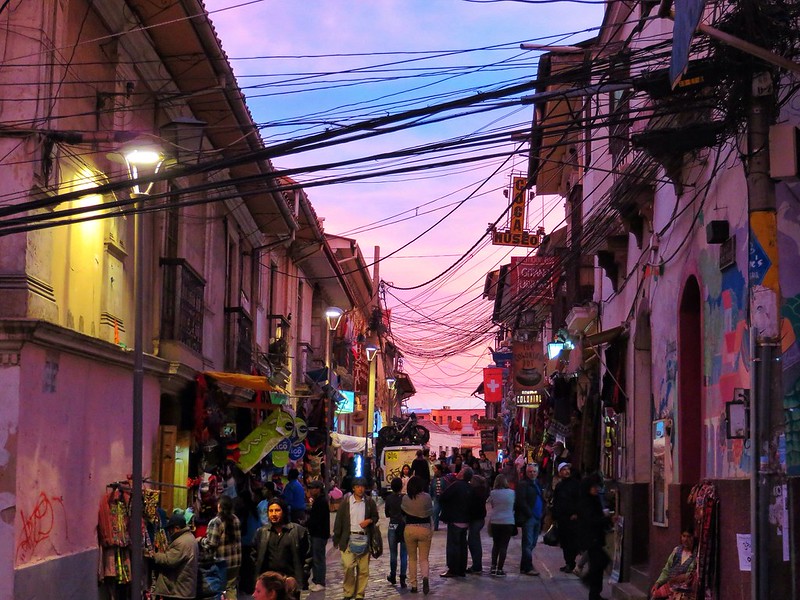



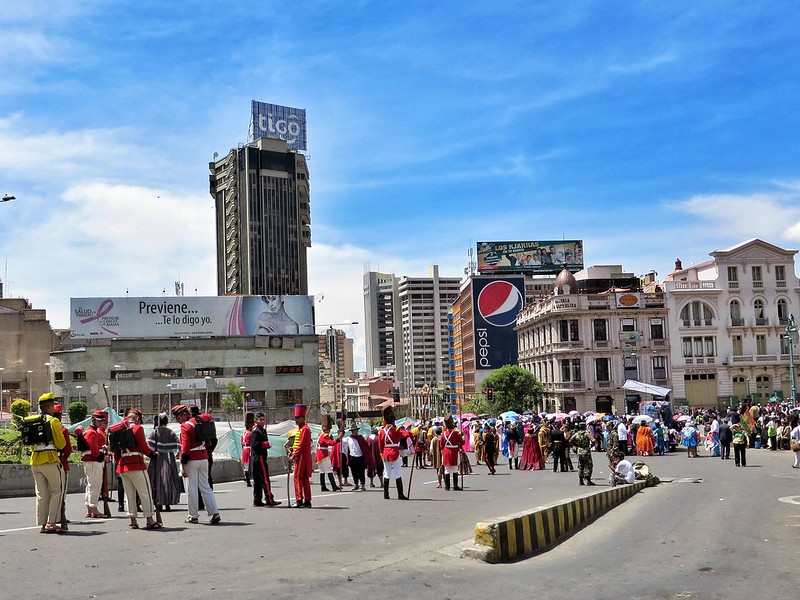

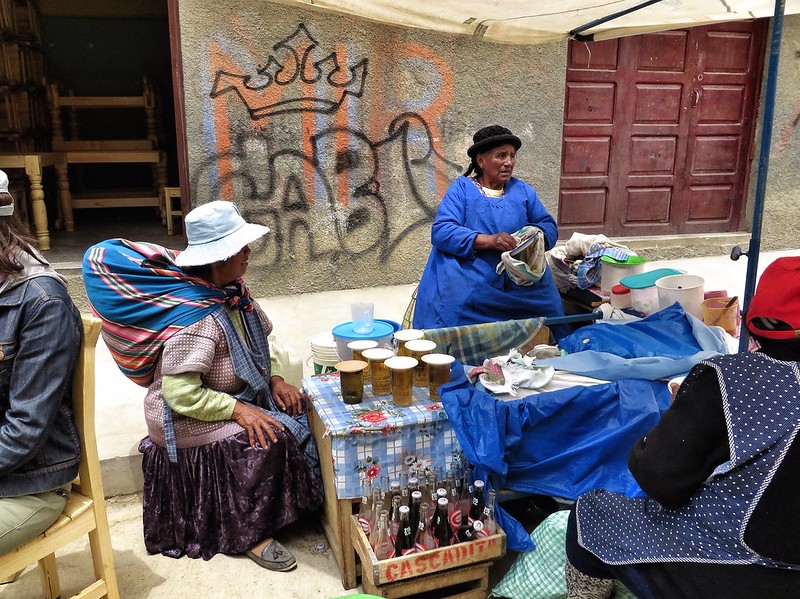
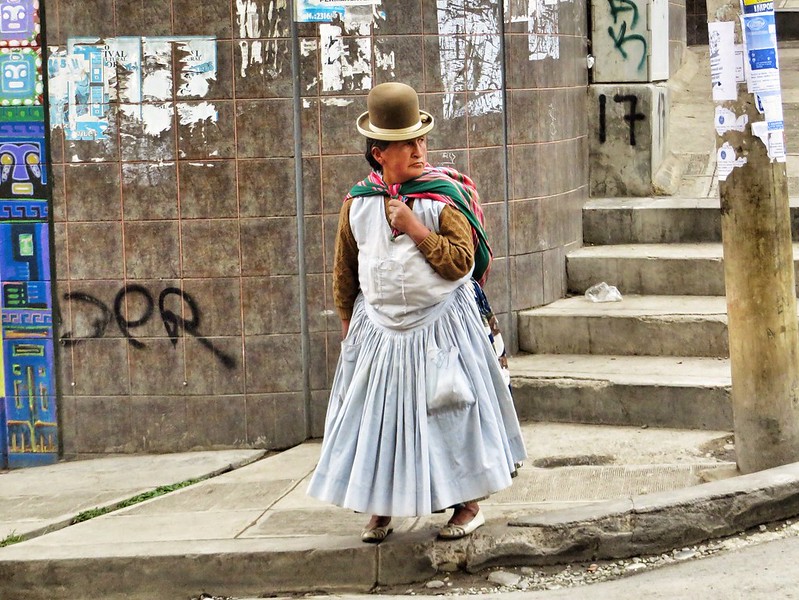
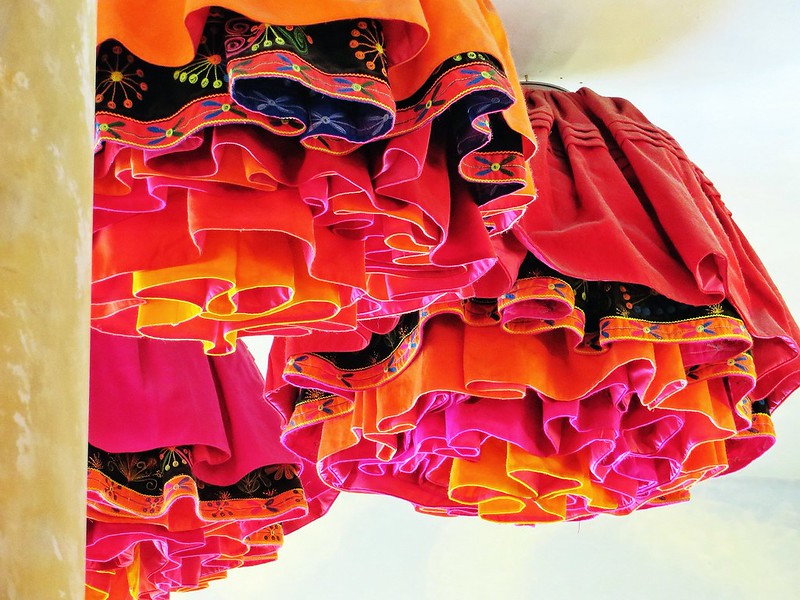

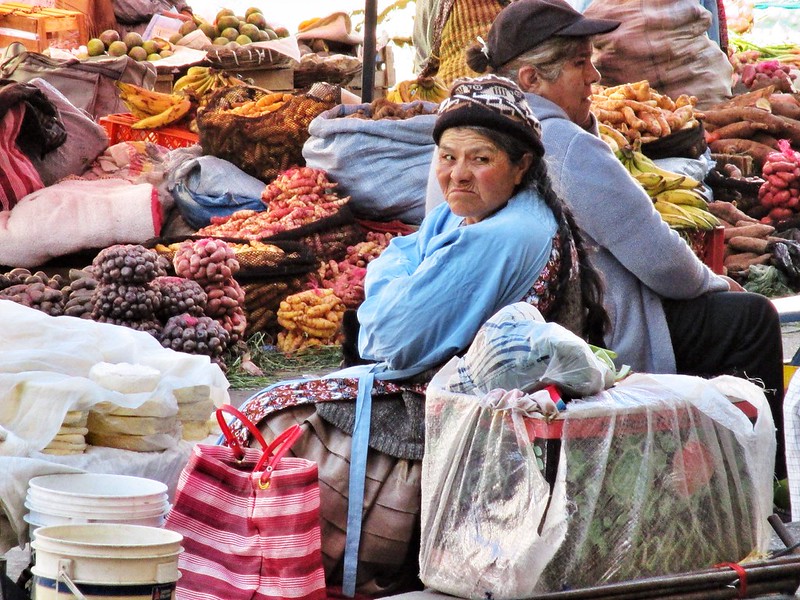
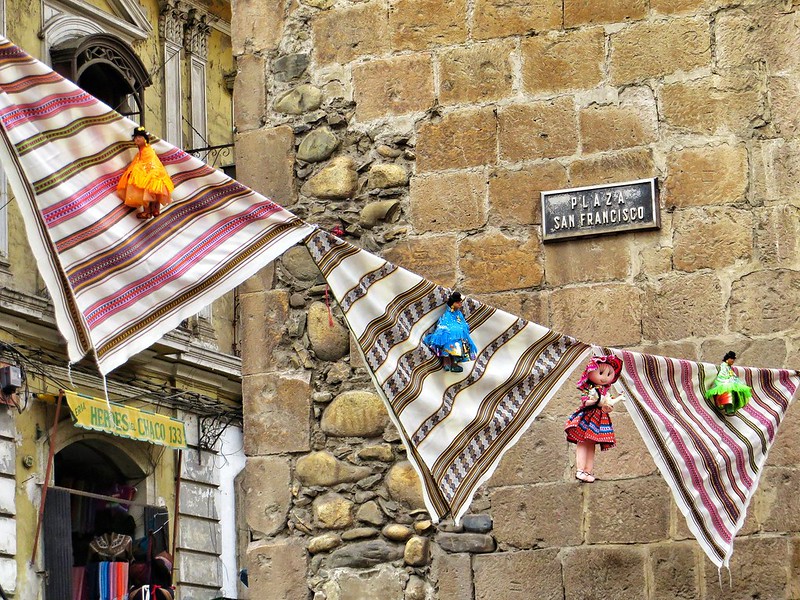
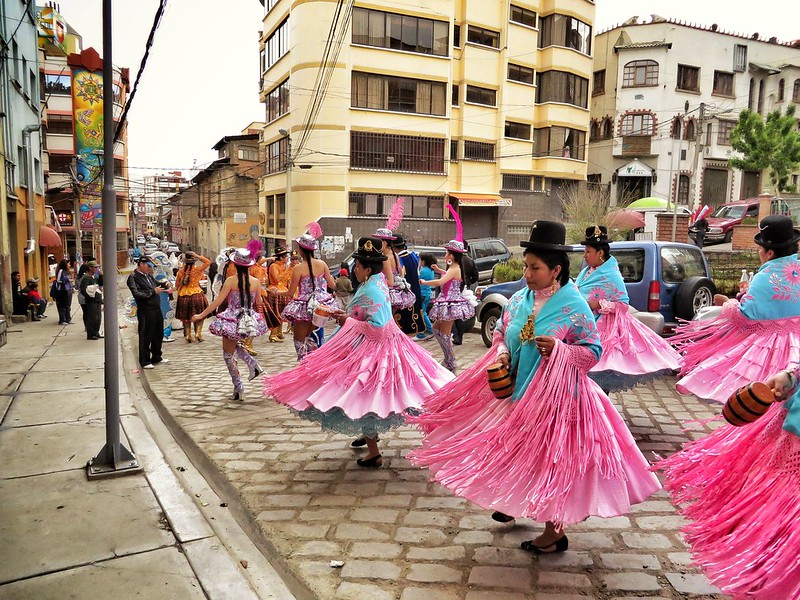
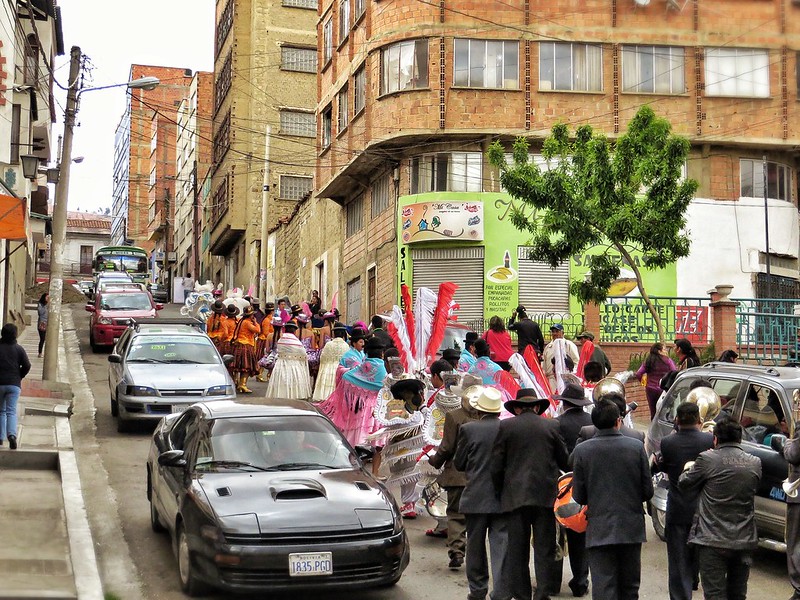
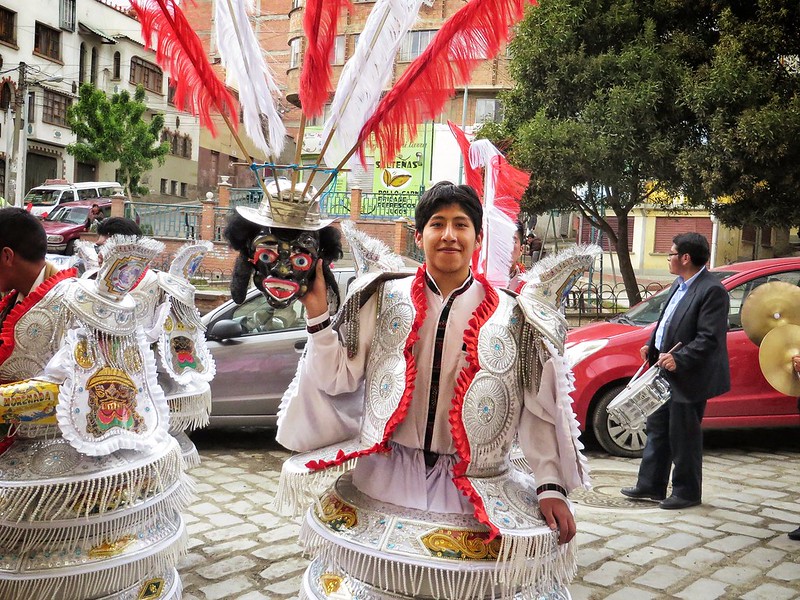

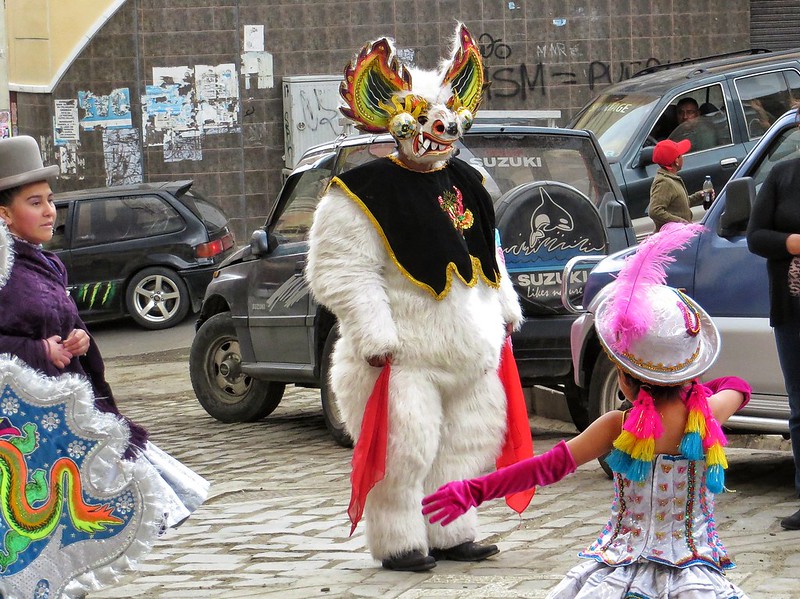
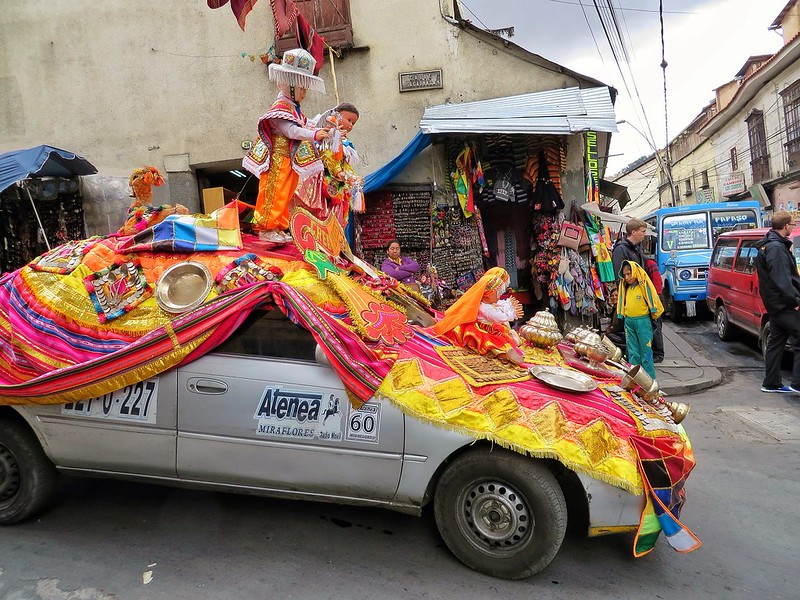
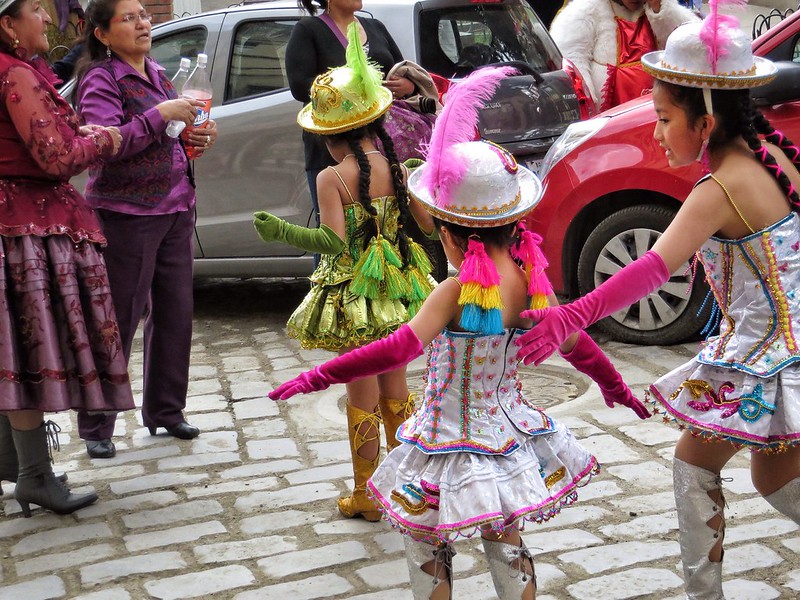
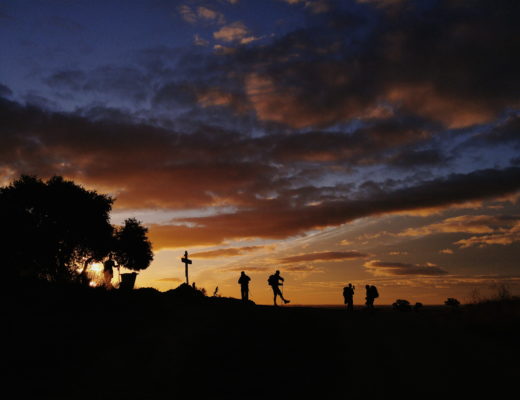
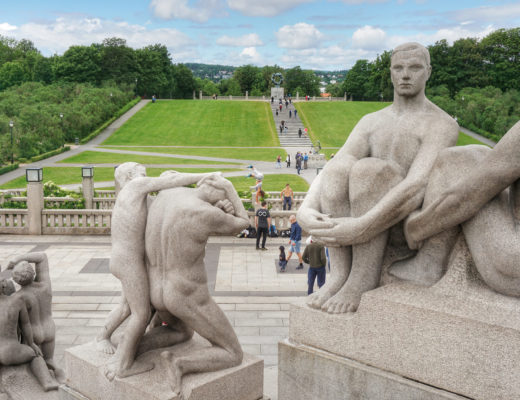
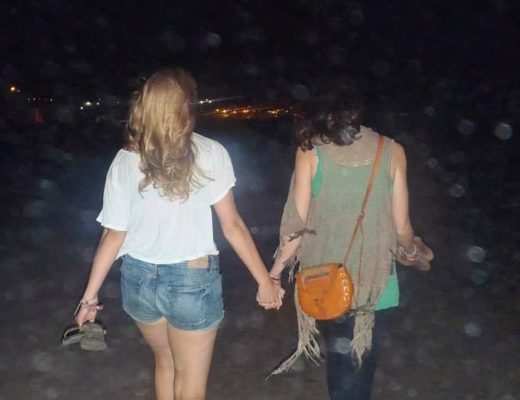
17 Comments
Rosie
November 1, 2013 at 3:49 amI’m so glad you spent enough time to get to know La Paz a bit better. So many people tell me how ‘unfriendly’ Bolivians are, but I think it’s a misunderstanding that stems from our (travellers/tourists) often unreal expectations of what locals should be like and how they should treat us foreigners.
Enjoy Sucre. It’s altitude and temperature are so much easier to deal with!
Flora
November 8, 2013 at 10:25 pmYou’ve hit the nail on the head, Rosie: I think we definitely make over-assumptions about how every single local should behave with tourists. Weird how we’d never exhibit the attitudes we expect when we’re in our own countries..! Sucre’s altitude is such a welcome change, too – although my internal temperature is totally thrown by it actually being sunny AND hot here!
5 coisas que você precisa saber antes de viajar para a Bolívia | Matador Brasil
April 29, 2014 at 11:58 pm[…] minha cabeça não há dúvida: as particularidades da cultura boliviana são bom motivo para que o país atraia tanto a atenção. Homens e […]
Do We Really Need Technology to Travel?
June 12, 2014 at 12:22 am[…] We seem to have reached a point where the act of travelling itself is only verified when it can be recorded or broadcast to other people; when an incredible travel experience feels bittersweet if you don't happen to have your camera. […]
Still in Love with South America
August 7, 2014 at 12:11 am[…] of impromptu celebrations I came across while wandering through a new place. I still remember the ones I’ve joined in with, […]
The Pueblo of Morado K'asa and its 200 Residents
April 17, 2015 at 11:18 am[…] La Paz? Es muy famoso – es un grand cuidad en Bolivia?” They shook their heads again. Bolivia’s pseudo-capital was only twelve hours away by bus, and they had absolutely no clue the place even […]
gringoinbolivia
May 31, 2015 at 10:49 pmDon’t suppose you remember the name of this Indian place? The only good one I know of in La Paz is Taj Mahal in San Miguel….
Flora
June 17, 2015 at 10:57 amI can’t remember the name, sadly, but it was a few streets away from the Witches market, and on the same road as my first hotel hence why I found it!
gringoinbolivia
June 18, 2015 at 7:53 pmMust be the Star of India. Unfortunately it’s really gone downhill in recent years.
Flora
May 16, 2016 at 9:39 pmI know this is a very late response but as I’ve been researching it — the Indian place I went to was on Calle Linares, just after the Lion Palace Hotel. The Star of India seems to have a different address so I wonder if ‘my’ place has closed down? It’s certainly not on TripAdvisor unfortunately…
gringoinbolivia
May 20, 2016 at 5:07 amYeah it couldn’t be the Star of India in that case. There have been a bunch of Asian (Thai/Chinese/Malaysian/Indian) restaurants that had almost identical menus over the years and that seem to come and go. Might have been one of those.
Skyler Haupt
October 22, 2016 at 2:43 amThank you for this article! I am contemplating spending 2 months in La Paz doing a social media assistant gig for a hostel and was concerned about some comments I’ve read online about safety (especially for solo female travelers). Reading your experience was a HUGE relief!
Flora
November 27, 2016 at 9:21 pmSo glad it’s helped to calm your nerves a bit, Skyler! I actually just replied to another girl’s comment on this article who’s spending 6 weeks studying Spanish in La Paz early next year – perhaps you two will be there at the same time!? I’m sure you’ll have a fab experience regardless though, it’s a really lovely city & just needs a bit of time spent getting to grips with it :p
Skyler Haupt
December 2, 2016 at 10:42 amThanks so much for pointing out Celine’s comment! I just replied back to her in hopes of connecting. I’ll be in La Paz all of January & February. 😀
Céline
November 9, 2016 at 4:10 pmI’ll be going to Bolivia next January, also planning to learn Spanish in La Paz for about 6 weeks. I’m a little nervous, since I’ve read quite a few rather negative comments about La Paz (It will also be my first backpacking trip alone (as a women) so that’s probably adding to the nervousness haha). I hope my experiences will eventually be as good as yours.
Flora
November 27, 2016 at 9:08 pmHey Céline, what a fantastic place to learn Spanish! Do you know what school you’ll be studying at? (I can highly recommend Pico Verde!) There’s probably equal amounts of positive and negative comments about La Paz online, but I spent a decent amount of time in the city and really loved it. Obviously the more Spanish you speak, the better you’ll do, but there’s a lot of travellers and expats in La Paz and it’s a pretty active city. Have you thought about doing some volunteer work etc when you’re there? Could be a great way to meet some more people and feel a bit less nervous 🙂
Skyler Haupt
December 2, 2016 at 10:40 amHi Céline! I’ll be in La Paz all of January & February. This is also my first trip outside my home country (USA) alone. If you would like to connect, please reach out via Facebook. My name is Skyler Haupt (same picture as on here). It’d be awesome to start out with a friend! Good luck to you on your travels either way!